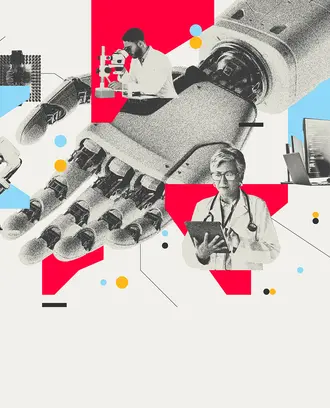In a climate where startups come and go like popcorn at a movie, founding and running a company for the long term can seem like a lost art.
Case in point: Of these electronics companies founded around MIT in the 1960s — Sprague Electric, Philco, Clevite Transistor, Transitron, Sylvania Electric Products, Analog Devices, Unitrode, George A. Philbrick Researches, and Nexus Research Laboratory — only one still exists today.
MIT alumnus Ray Stata has led Analog Devices Inc. for 54 years.
Founded in 1965, Analog Devices Inc. had revenue of more than $6 billion in fiscal year 2018. It still makes its original product — operational amplifiers. It’s still headquartered in Norwood, Massachusetts, and, as one of the few semiconductor companies on the East Coast, it still manufactures chips in a fabrication plant in Wilmington, Massachusetts.
And as of February 2019, its co-founder, Ray Stata, still chairs the Analog Devices board.
To what does Stata, who earned both a master's and a bachelor's degrees in electrical engineering at MIT, attribute his company’s longevity, and his own? He offers four pieces of advice:
Always be iterating
From the beginning, Stata studied and tried to practice organizational learning, an attribute that enabled Analog Devices to adapt to tectonic shifts in technologies and markets.
At first, Analog Devices built operational amplifier modules by hand for the defense and instrumentation markets. But Stata was watching a new technology emerge — the integrated circuit. He foresaw how the integrated circuit business would overtake modules.
“Each year ICs got better, and they were an order of magnitude cheaper,” he said in a recently published history of the company. “I concluded that we had to take bold steps to learn how to design and manufacture ICs, or our success would be short-lived.”
When the PC business boomed in the 1980s, Analog Devices had to change from selling low volumes of high-performance, high-profit-margin parts to military and instrumentations markets to selling inexpensive, easily manufactured products in high volumes to the computer market. “Many of our most sacred beliefs had to change,” Stata said.
Today, on the cusp of the “internet of things,” Analog Devices has expanded into sensors, processors, software, and wireless connectivity, and is selling to even more varied markets.
Take calculated risks
Although Stata saw the writing on the wall with integrated circuits, by 1969 the company had gone public, and he couldn’t convince its board of directors that Analog Devices needed to embrace the new technology.
So Stata devised a workaround: He borrowed against his Analog Devices stock and funded his own startup, called Nova Devices, to design and manufacture integrated circuits. Within two years, Analog Devices’ board bought the startup, and within eight years, integrated circuits made up more than half of the firm’s revenue.
Another instance of risk and reward: In the mid-1970s the company made the unlikely choice of Limerick, Ireland, as the site of a second fabrication plant.
Although the Irish government was courting tech companies, offering attractive subsidies and training programs, industry colleagues thought it was a crazy decision, Stata said, because there was no semiconductor business there. The area had neither the industrial infrastructure nor the technical manpower for integrated circuit manufacturing.
What clinched the deal for Stata was the fact that a new college — the National Institute for Higher Education — had just opened in Limerick with a focus on engineering and technology. Stata met the school’s founder and president and forged a partnership: The company helped the school build its curriculum, and the school trained engineers who often went directly to Analog Devices.
It was one of the riskiest decisions in the company’s history, “but it was also one of the most important factors in Analog Devices’ success,” Stata said. The school, renamed the University of Limerick in 1989, turned out such talent that many of its early graduates reached the company’s highest executive and technical levels, including its current CEO Vince Roche.
Maintain a core focus and branch out from there
The balance between excelling at what you do best and adapting to new markets is one of the biggest challenges for any company. Analog Devices walked that tightrope by always staying focused on what Stata called “signal processing” — that is, the conversion and processing of analog signals to digital and vice versa.
Even when the company shifted from modules to integrated circuits, or from defense to computer products, signal processing was its lodestar. Different customers and markets needed to do different things with signals, and Analog Devices was able to branch out by understanding what its customers needed in their particular application and market.
Cross oceans to hire the best people
From day one, Analog Devices hired the best talent it could find. In its early days, the company recruited and hired some of the best analog designers in the country. And decades before telecommuting, Stata went out of his way to accommodate their needs.
One marquee engineer, Barrie Gilbert, needed to stay in England to care for his aging mother. Stata not only let him work from there, but gave him the resources to build an engineering lab in his home.
Stata gave employees a lot of autonomy at a time when most companies favored traditional top-down hierarchies. “Hire great people, and stay out of their way,” is one of Stata’s legendary sayings. Engineers thrived in this environment, which continues today. “There is an unusual degree of freedom and an understanding that it’s OK to be a rebel,” said Gilbert, who was hired in 1972 and is still with the company.
Fifty-four years after he founded Analog Devices, Stata hopes these principles will live on. “Will Analog Devices exist 50 years hence? I hope so,” he writes in the book’s foreword. “If it does, it will be because it remained true to its core values and continued to learn, adapt, and innovate.”
Harbert is a technology/business journalist and ghostwriter. She worked with Ray Stata to write Analog Devices’ corporate history, “The Innovation Engine: The first 50 years of Analog Devices.”



